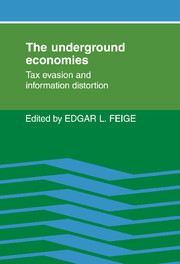Book contents
- Frontmatter
- Contents
- List of contributors
- Preface
- Introduction
- Part I The meaning, measurement, and policy implications of the underground economies
- Part II The underground economy in Western developed nations: measurement in different laboratories
- 5 Monetary perspective on underground economic activity in the United States
- 6 The unrecorded economy and the national income accounts in the Netherlands: a sensitivity analysis
- 7 Assessing the underground economy in the United Kingdom
- 8 The underground economy in the Federal Republic of Germany: a preliminary assessment
- 9 The underground economy in Sweden
- 10 The irregular economy of Italy: a survey of contributions
- 11 The hidden economy in Norway with special emphasis on the hidden labor market
- 12 Canada's underground economy
- 13 The underground economy in France
- Part III The underground economy under central planning
- Bibliography
7 - Assessing the underground economy in the United Kingdom
Published online by Cambridge University Press: 20 October 2009
- Frontmatter
- Contents
- List of contributors
- Preface
- Introduction
- Part I The meaning, measurement, and policy implications of the underground economies
- Part II The underground economy in Western developed nations: measurement in different laboratories
- 5 Monetary perspective on underground economic activity in the United States
- 6 The unrecorded economy and the national income accounts in the Netherlands: a sensitivity analysis
- 7 Assessing the underground economy in the United Kingdom
- 8 The underground economy in the Federal Republic of Germany: a preliminary assessment
- 9 The underground economy in Sweden
- 10 The irregular economy of Italy: a survey of contributions
- 11 The hidden economy in Norway with special emphasis on the hidden labor market
- 12 Canada's underground economy
- 13 The underground economy in France
- Part III The underground economy under central planning
- Bibliography
Summary
In a cautious review of the evidence and measurement methodologies used in assessing the magnitude of the hidden economy in the United Kingdom, I argued that whereas “any conclusion is a matter of faith rather than hard facts…the effect of all the data taken together makes it difficult to believe in a figure of less than five per cent” (O'Higgins 1980, p. 36). Since then the official authorities – the Inland Revenue (IR) and the Central Statistical Office (CSO) – have discussed the question openly; IR compliance enforcement activity has shifted as a consequence of a new perception of where tax evasion is most prevalent – and most controllable; a working group of the Economics Committee of the Social Science Research Council (SSRC) has discussed and reported on the research questions relevant to the theory and measurement of the hidden economy; and studies have appeared with estimates of the unobserved economy that range from 2 to 15% of official national income at the end of the 1970's. What I want to investigate here is whether this profusion of material has reduced confusion about the magnitude and trend of the U.K. unobserved economy.
The essential conclusions of this chapter are that although monetary measures indicate unobserved economies of the order of 10–15% and other methods produce estimates in the range 3–8%, there is some suggestive evidence that the relative growth of the unobserved economy was checked and perhaps slightly reversed in the mid-1970's. This would accord with the intuitive suggestion that the scope and demand for unobserved activities is greatest in boom years when the formal economy is tight.
- Type
- Chapter
- Information
- The Underground EconomiesTax Evasion and Information Distortion, pp. 175 - 196Publisher: Cambridge University PressPrint publication year: 1989
- 13
- Cited by

